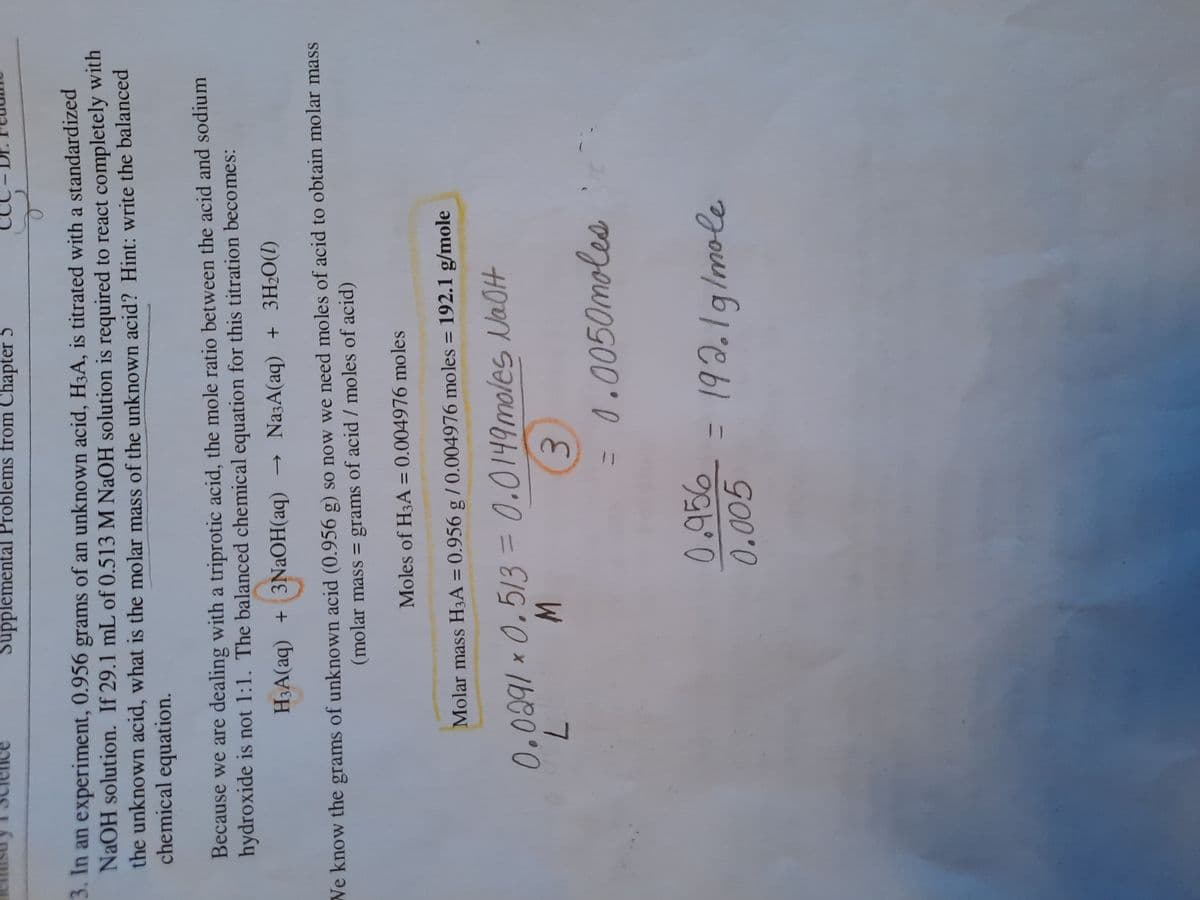For the parts circled in orange, my question is since we are trying to find moles of H3A here, are we dividing by 3 because there are 3 H, or are we dividing by 3 because there are 3NaOH? Basically, why are we dividing by 3
For the parts circled in orange, my question is since we are trying to find moles of H3A here, are we dividing by 3 because there are 3 H, or are we dividing by 3 because there are 3NaOH? Basically, why are we dividing by 3
Chemistry: The Molecular Science
5th Edition
ISBN:9781285199047
Author:John W. Moore, Conrad L. Stanitski
Publisher:John W. Moore, Conrad L. Stanitski
Chapter3: Chemical Reactions
Section: Chapter Questions
Problem 153QRT
Related questions
Question
For the parts circled in orange, my question is since we are trying to find moles of H3A here, are we dividing by 3 because there are 3 H, or are we dividing by 3 because there are 3NaOH? Basically, why are we dividing by 3

Transcribed Image Text:Supplemental Problems from Chapter 5
3. In an experiment, 0.956 grams of an unknown acid, H3A, is titrated with a standardized
NaOH solution. If 29.1 mL of 0.513 M NaOH solution is required to react completely with
the unknown acid, what is the molar mass of the unknown acid? Hint: write the balanced
chemical equation.
Because we are dealing with a triprotic acid, the mole ratio between the acid and sodium
hydroxide is not 1:1. The balanced chemical equation for this titration becomes:
H3A(aq) +3NAOH(aq) →
N33A(aq) + 3H2O(I)
We know the grams of unknown acid (0.956 g) so now we need moles of acid to obtain molar mass
(molar mass = grams of acid / moles of acid)
Moles of H3A = 0.004976 moles
Molar mass H3A = 0.956 g / 0.004976 moles = 192.1 g/mole
%3D
0.0291*0,513
=
3D0.0149molesNaOH
3.
=0.0050moles
7
131
0.956
= 193.1g/mole
%3D
0.005
Expert Solution
This question has been solved!
Explore an expertly crafted, step-by-step solution for a thorough understanding of key concepts.
Step by step
Solved in 2 steps with 1 images

Knowledge Booster
Learn more about
Need a deep-dive on the concept behind this application? Look no further. Learn more about this topic, chemistry and related others by exploring similar questions and additional content below.Recommended textbooks for you

Chemistry: The Molecular Science
Chemistry
ISBN:
9781285199047
Author:
John W. Moore, Conrad L. Stanitski
Publisher:
Cengage Learning

Chemistry
Chemistry
ISBN:
9781305957404
Author:
Steven S. Zumdahl, Susan A. Zumdahl, Donald J. DeCoste
Publisher:
Cengage Learning

Chemistry: An Atoms First Approach
Chemistry
ISBN:
9781305079243
Author:
Steven S. Zumdahl, Susan A. Zumdahl
Publisher:
Cengage Learning

Chemistry: The Molecular Science
Chemistry
ISBN:
9781285199047
Author:
John W. Moore, Conrad L. Stanitski
Publisher:
Cengage Learning

Chemistry
Chemistry
ISBN:
9781305957404
Author:
Steven S. Zumdahl, Susan A. Zumdahl, Donald J. DeCoste
Publisher:
Cengage Learning

Chemistry: An Atoms First Approach
Chemistry
ISBN:
9781305079243
Author:
Steven S. Zumdahl, Susan A. Zumdahl
Publisher:
Cengage Learning


Chemistry: Principles and Reactions
Chemistry
ISBN:
9781305079373
Author:
William L. Masterton, Cecile N. Hurley
Publisher:
Cengage Learning
